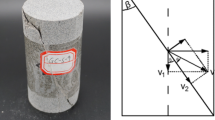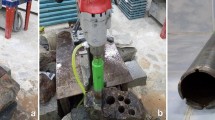Abstract
This study aimed to evaluate the effect of length-to-diameter ratio (L/D) of a rock core specimen on uniaxial compressive strength (UCS) and to investigate the optimum L/D range for different rock types. For this purpose, a considerable amount of rock block was compiled and a series of laboratory tests were carried out to determine some geo-mechanical properties of the rocks and the UCS values of test specimens having different L/Ds. Some assessments were made on the limit L/Ds [(L/D)lim] based on theoretically calculated values and those experimentally observed, and then some easily determined properties of the studied rocks were statistically evaluated to predict (L/D)lim values. By considering the results of these evaluations, some L/D classes were suggested for selection of the L/D intervals of rock specimens before uniaxial compression tests. In addition, an equation was proposed to correct the UCS values obtained from core specimens shorter than lower limits of the suggested L/D classes.
















Similar content being viewed by others
References
ASTM (1994) American society for testing and materials. Annual Book of ASTM Standards. Vol 04.08, Philadelphia
ASTM (2000) American society for testing and materials. Annual Book of ASTM Standards. Vol 04.08, Philadelphia
Bieniawski ZT (1968) The effect of specimen size on compressive strength of coal. International Journal of Rock Mechanics 5:325–335
Bieniawski ZT (1972) Propagation of brittle fracture in rock. Proceedings of 10th symposium on rock mechanics, AIME, New York, pp 409–27
Coates DF (1965) Rock Mechanics Principles. Mines Branch Monograph 874, Ottawa: Queen’s Print, pp 280
Hawkins AB (1998) Aspects of rock strength. Bull Eng Geol Environ 57:17–30
Hodgson K, Cook NGW (1970) The effects of size and stress gradient on the strength of rock. Proceedings of 2nd Congress of International Society of Rock Mechanics, Belgrade, Vol 2, pp 3–5
Hoek E, Brown ET (1980) Underground excavations in rock. Institution of mining and metallurgy, Hertford. Stephen Austin and Sons Ltd., London, p 527
Hoek E, Brown ET (1997) Practical estimate of rock mass strength. Int J Rock Mech Min Sci 34(8):1165–1186
Hoskins JR, Horino FG (1969) The influence of spherical head size and specimen diameter on the uniaxial compressive strength of rocks. US Bureau of Mines Report of Investigations, No: 7234
Hudson JA, Harrison JP (1997) Engineering Rock Mechanics: An Introduction to the Principles. Pergamon, 444pp
ISRM (2007) The complete ISRM suggested methods for rock characterization, testing and monitoring: 1974–2006. In: Ulusay R and Hudson JA, eds. Suggested methods prepared by the commission on testing methods, ISRM, Compilation arranged by the ISRM Turkish National Group, Kozan ofset, Ankara
ISRM (2015) The ISRM Suggested Methods for Rock Characterization, Testing and Monitoring: 2007–2014. R Ulusay (eds), Springer International Publishing, Switzerland
John M (1972) The influence of length-to-diameter ratio on rock properties in uniaxial compression; a contribution to standardisation in rock mechanics testing. Rep S Afr CSIR No ME1083/5
Labuz J, Bridell JM (1993) Reducing frictional constraint in compression testing through lubrication. Int J Min Geol Eng Abstr 30:451–455
Lockner DA (1995) Rock failure. In: Thomas JA (ed) Rock Physics and Phase Relations, A Handbook of Physical Constants, AGU References Shelf 3, pp 127–47
Marinos P, Hoek E (2001) Estimating the geotechnical properties of heterogeneous rock masses such as flysch. Bull Eng Geol Environ 60:85–92
Mogi K (1962) The influence of the dimensions of specimens on the rock fracture strength of rocks. Bull Earthquake Res 40:175–185
Mogi K (1966) Some precise measurements of fracture strength of rocks under uniform compressive stress. Felsmechanik und Ingenieurgeologie 4:41–55
Mogi K (2007) Experimental rock mechanics. Taylar & Francis, London, p 361
Obert L, Duvall WI (1967) Rock mechanics and the Design of Structures in rock. John Willy & Sons, London, p 650
Obert L, Windes SL, Duvall WI (1946) Standardized tests for determining the physical properties of mines rocks. US Bureau of Mines Report of Investigations, No:3891
Özkan I, Özarslan A, Geniş M, Özşen H (2009) Assessment of scale effects on uniaxial compressive strength in rock salt. Environ Eng Geosci 15:91–100
Pan ZP, Feng XT, Hudson JA (2009) Study of failure and scale effects in rocks under uniaxial compression using 3D cellular automata. Int J Rock Mech Min Sci 46:674–685
Pappalardo G, Mineo S (2017) Investigation on the mechanical attitude of basaltic rocks from Mount Etna through InfraRed thermography and laboratory tests. Constr Build Mater 134:228–235
Pappalardo G, Mineo S, Marchese G (2013) Effects of cubical specimen sizing on the uniaxial compressive strength of Etna volcanic rocks (Italy). Italian Journal of Engineering Geology and. Environment 2:45–54
Pappalardo G, Mineo S, Monaco C (2016) Geotechnical characterization of limestones employed for the reconstruction of a UNESCO world heritage baroque monument in southeastern Sicily (Italy). Eng Geol 212:86–97
Pratt HR, Black AD, Brown WS, Brace WR (1972) The effect of specimen size on the mechanical properties of unjointed diorite. Int J Rock Mech Min Sci 9:513–529
Protodyakonov MM (1969) Method of determining the strength of rocks under uniaxial compression. In: Protodyakonov MM, Koifman GI (eds) Mechanical properties of rocks, translated from Russian. Israel Program for Scientific Translations, Jerusalem
Protodyakonov MM, Koifman MI (1963) The scale effect in investigations of rock and coal. Proceedings of 5th Congress Intnl. Bureau Rock Mechanics, Leipzig
Sheorey PR (1997) Empirical Rock Failure Criteria AA Balkema, Rotterdam, pp 176
Thuro K, Plinninger RJ, Zäh S, Schütz S (2001) Scale effects in rock strength properties. Part 1: unconfined compressive test and Brazilian test. In: Sarkka P, Elorata P, eds. ISRM regional symposium, EUROCK 2001, Rock Mechanics – A Challenge for Society, Espoo, pp 169–74
Tuncay E, Hasancebi N (2009) The effect of length to diameter ratio of test specimens on the uniaxial compressive strength of rock. Bull Eng Geol Environ 68:491–497
Tuncay E, Tunar Ozcan N (2011) An evaluation on the effect of test core shape on uniaxial compressive strength and elastic modulus of rock. In: Laverov NP, Osipov VI, eds. Proceeding of Environmental Geosciences and Engineering Survey for Territory Protection and Population Safety, EngeoPro2011, Moscow-Russia, pp 591–595
Tuncay E, Tunar Ozcan N, Coskun A (2012) Investigation of the effect of test specimen shape (length to diameter ratio) on uniaxial compressive strength of rocks. TÜBİTAK, Project no: 109Y307, pp 104 (in Turkish)
Tuncay E, Tunar Ozcan N, Coskun A (2015) A new approach for determination of length to diameter ratio of specimen used for uniaxial compressive strength test. In: Ulusay R, Ekmekçi M, Ersoy H, Fırat Ersoy A, eds. Proceeding of National Engineering Geology Symposium, Muhjeo2015, Trabzon, Turkey, pp 246–53
Ulusay R, Sulukcu S, Gokceoglu C (2001) Draft ISRM suggested method for determining block punch strength index (BPI). Int J Rock Mech Min Sci 38:1113–1119
Acknowledgements
This research was conducted by the financial support of The Scientific and Technical Research Council of Turkey (TUBITAK) with a project number of 109Y307.
Author information
Authors and Affiliations
Corresponding author
Rights and permissions
About this article
Cite this article
Tuncay, E., Özcan, N.T. & Kalender, A. An approach to predict the length-to-diameter ratio of a rock core specimen for uniaxial compression tests. Bull Eng Geol Environ 78, 5467–5482 (2019). https://doi.org/10.1007/s10064-019-01482-6
Received:
Accepted:
Published:
Issue Date:
DOI: https://doi.org/10.1007/s10064-019-01482-6




